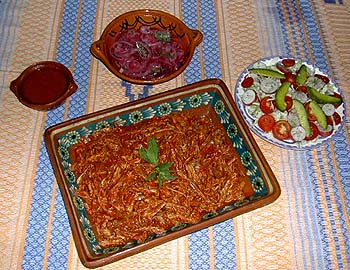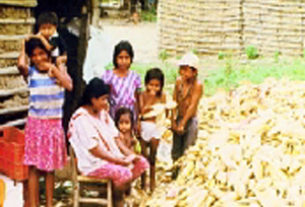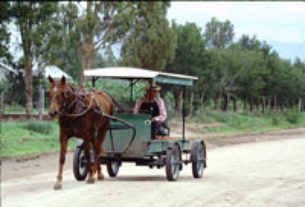The Mexican state of Yucatan, located on the peninsula of the same name, is the home of one of the most distinctive regional cuisines in the country. A long tradition of fine dining, going back to the ancient Maya and incorporating sophisticated European dishes, is very much in evidence in the cities, towns and villages scattered throughout this fertile area. Traveling in the Yucatan, one is constantly reminded of the people’s unbroken culinary link with their ancestors.
Bordering on the Gulf of Mexico to the north, and the states of Campeche and Quintana Roo on either side, Yucatan is a limestone plain where the infiltration of moisture has formed grottos, caverns and fissures through which subterranean waters flow. The corn, beans, vegetables and fruit grown here are basically the same foodstuffs that were eaten five hundred years ago when the Spaniards explored the Yucatan, and had been consumed for at least another half a millennium before that.
TRADITIONAL FOODS: FROM MAYAN TIMES TO MODERN TIMES
Although the Europeans arrived well after the glory days of the Classic Maya, dependence on corn as the basic staple food was still very much in evidence and continues to this day. Maíz played an integral part in practically every lifetime ceremony, from cutting the newborn’s umbilical cord over a corn cob, to placing a piece of corn dough in the mouth of the deceased. It was used as both solid and liquid food, most commonly prepared as a piece of once-ground corn dough dissolved in water, called posolli in Nahuatl and keyem by the Maya. Posolli, as we found it in Yucatecan markets, is still very much in use, especially by poor people, and remains a thin gruel rather than the hearty hominy pozole of central Mexico.
When the Spaniards reached the shores of the Yucatan in 1517, the Maya met them with corn dough to make posolli. They also brought ‘roasted fowl’, which could have been one of a number of native species, including the turkey, muscovy duck, currasow and guan. The turkey, especially, was important in the world of ritual and, like corn, remains important today in ceremonies for curing, planting, and praying for rain. In our travels throughout Yucatan, we rarely encountered a restaurant which did not have at least one traditional turkey dish, sometimes replaced by chicken, on the menu.
The Maya were also known as great cultivators of fruit. Although the Europeans forced them to cut down their beloved orchards, the ability to grow magnificent fruit trees was not lost. Today tamarinds, plums, mamey, avocados and other tropical varieties flourish and are enjoyed in the delicious nieves – ices – and fruit drinks which are so popular in the hot climate. Bitter oranges, with their strong influence on Yucatecan marinades and salsas, are found throughout the state.
Honey, too, is an important part of the Yucatecan diet and has been used for centuries to sweeten corn drinks and to make an alcoholic ritual drink called balché. A delicious honey liqueur called Xtabentun, which we bought in Merida and brought back to central Mexico with us, was only one of the gastronomical delights that we found in the markets and restaurants of this beautiful city.
MERIDA, THE WHITE CITY: MARKETS AND RESTAURANTS
Called La Ciudad Blanca for the white stone used to build the stunning homes and palaces of Yucatan’s hennequin barons, Mirada is filled with churches and temples, each with its own small plaza, where people congregate to enjoy salbutes, panuchos, and other corn dough based street snacks. Between those and the fruit ices, we were never long without a delicious tidbit to ‘tide us over’ between meals in some of Merida’s numerous restaurants. Although prices vary to suit every budgetary range, hospitality and graciousness are constant.
At La Prosperidad, a palapa-roofed bastion of regional cooking, we enjoyed local specialties while listening to tropical music. Besides tasting, nothing is more revealing to a food writer than being invited into the kitchen, something which happened frequently on the Yucatan trip. La Prosperidad’s employees were patient in the face of questions, sharing recipes for some of the wonderful botanas we had enjoyed at the bar, including the tamal called brazo de reina and the delicious, enchilada-like papadzules, both of which harken directly back to pre-Hispanic times and use the very common Mayan ingredient pepitas, toasted pumpkin or squash seeds.
Another restaurant, Las Almendras, although more geared toward tourists, did have a wide selection of Yucatecan dishes, including the obviously European-influenced queso relleno, which consists of a whole Edam cheese hollowed out and stuffed with the spiced ground meat called picadillo. Despite the fact that menus with food photos nearly always spell disaster, in this case it was helpful to those not familiar with local food. Chilmole, for example, although scrumptious, might come as a shock to a diner not expecting turkey covered with a nearly jet-black sauce.
In addition to eating in restaurants both large and small, exploring Merida’s markets was another enlightening culinary experience. Bright mounds of recados, or seasoning pastes, are logically displayed next to the isles of chickens with which they are most commonly served. Inquiring why the chickens all had stark white skin, we were told that this particular breed holds up better in the hot climate than yellow-skinned chickens.
For those wishing to make their own recados for chicken, turkey and other meat, all of the ingredients are right there in the spice section: the achiote seeds of the bixella orellana tree, used in preparing the recado rojo used to coat the famous cochinita pibil; the fat, fragrant allspice berries that go into chilmole; the cloves, black peppercorns, cinnamon sticks and coriander seeds for the beef seasoning recado para bistec.
RUINS AND VILLAGES: CULINARY DISCOVERIES IN THE COUNTRYSIDE

Tearing ourselves away from Merida’s markets, we set out to see some of the impressive Mayan ruins found throughout the area. On the way to Uxmal, the beautiful archeological site of a building complex constructed in the ornate Puuc style, we stopped to see the massive colonial churches in Umán and Muná. It is said that the well-known pollo pibil was invented in Muná’s Convento de la Asunción. Whether or not that is true, there is evidently a strong culinary tradition here, with food booths set up all over town selling a variety of Yucatecan antojitos. We especially enjoyed the grilled meat dish called poc chuc, cooked fresh to order over wood charcoal fires.
Near the ruins themselves, at the Antigua Hacienda de Uxmal, there is a hotel and restaurant with a reputation for good food, but after a walk around the ruins we decided to take a detour to the ceramics town of Ticul, home of pollo ticuleño, succulent chicken baked in banana leaves, in the tradition of cochinita pibil and several other dishes that were once prepared in a pib, or pit oven in the ground.
Another archeological site not to be missed is Chitchén Itzá, a pre-Hispanic civic and religious center which contains the largest ball court in Mesoamerica. On the way, we stopped at Acanceh, a hammock-making center, where the sixteenth century church was constructed next to the base of a large pyramid. This village carries on the tradition of cooking and eating deer meat, although due to the present-day scarcity of deer, this dish is prepared only on special occasions, such as Acanceh’s celebration of the feast of Our Lady of Guadalupe on December 12. Other specialties, such as fruit sorbets, buñuelos, pipian, cochinita and relleno negro are also served at fiesta time.
Another town worth seeing on the way from Merida to Chitchén Itzá is Izamal, whose convento has the largest atrium in the Americas, to which thousands of pilgrims flock on December 8, when the Izamal celebrates its fiesta. All of the houses are painted a beautiful creamy yellow color to match the church, making the town a particularly attractive place to stop, have a bite to eat, and possibly take a guided horseback tour of the area or a dip in one of the underground natural pools. Izamal is known for sopa de lima, as well as parchment-wrapped chicken, pork empanadas and a traditional atole called tanchucuá, made with fresh corn, chocolate, allspice and sugar.
Another possible stop on the Chitchén Itzá route is Valladolid, the second-most important city in the state, after Merida. Its colonial buildings were silent witnesses to the Caste War, Yucatan’s precursor to the Mexican Revolution. Valladolid is proud of its many restaurants offering traditional Yucatecan food, and is the undisputed home of pavo oriental, a delicious, vinegary turkey dish, as well as lomitos, which could be described as Yucatan’s version of carnitas.
PROGRESO: SEAFOOD SPECIALTIES
North of Merida is the port of Progreso, whose beaches attract city folk from Merida during vacation time, especially Holy Week and summer weekends. A good variety of unique local seafood is found here and appetizingly prepared in Progreso’s restaurants. Esmedregal, a type of jack fish, is fried and served with the hot but tasty salsa de chile xcatic. Pescado tikin-xic, a specialty of La Carabela restaurant, is fresh grouper prepared with a classic Yucatecan achiote paste and baked in banana leaves. Squid, caught in season in huge nets, is an ingredient in the regional version of sopa de mariscos, seafood soup.
Further east along the coast is Rio Lagartos, a town of pastel-painted houses at the mouth of the river of the same name. The local cuisine features the small river snails, most often made into ceviche, mysteriously called chivitas – ‘little goats.’
Whether or not ‘little goats’ sound tempting, many of Yucatan’s dishes are downright tantalizing. The tasty marinades and pastes that season the grilled or baked meat, chicken and fish are some of the most inspired flavor combinations in Mexico. Many travelers to the state have remarked on the fact that even those who dislike the hot chiles that permeate some regional food are pleasantly surprised.
The very hot chiles habaneros are served in a salsa on the side, rather than as part of the dishes themselves. For chile lovers and non-chile lovers alike, the following recipes should lead to a memorable meal or two. Thanks to its huge rise in international popularity, achiote paste, indispensable in Yucatecan cooking, is now widely available in the United States and several other countries. Thankfully, you don’t have to be able to pronounce the names of these dishes in order to enjoy them.
RECIPES:
- Cochinita Pibil: Baked Marinated Pork
- Pollo Ticul: Yucatecan Style Chicken
- Chilmole: Turkey in a Dark Spice Sauce
- Pescado Tikin-Xic: Yucatecan Baked Fish
- Puchero Yucateco de Tres Carnes: Yucatecan Three-Meat Stew
- Frijoles Estilo Yucateca: Yucatecan Style Beans
- Sopa de Lima: Lime Soup
- Pasta de Achiote: Achiote Paste
- Salbutes Yucatecos: Yucatecan Salbutes


